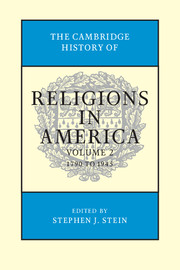Book contents
- Frontmatter
- Contents
- Contributors
- Editor's Introduction
- SECTION I RELIGION IN NORTH AMERICA
- SECTION II RELIGIONS IN THE NEW NATION, 1790–1865
- SECTION III CHANGING RELIGIOUS REALITIES
- 11 Diversity, Revival, Rivalry, and Reform: Protestant Christianity in the United States, 1800–1950
- 12 American Catholics, 1800–1950
- 13 American Judaism, 1820–1945
- 14 Formation and Consolidation of African American Religious Communities, 1865–1945
- 15 Eastern Orthodox Christianity in America
- 16 New Religious Movements
- 17 American Indian Religions in America, 1790–1945
- 18 Why Muslims Matter to American Religious History, 1730–1945
- 19 Asian Religions in the United States: The Role of the 1893 World’s Parliament of Religions in Shaping an Evolving Pluralist Ideology
- 20 Metaphysical Movements
- SECTION IV RELIGIOUS RESPONSES TO MODERN LIFE AND THOUGHT
- SECTION V COMPARATIVE ESSAYS
- SECTION VI RELIGION AND DIVERSE AREAS
- Index
- References
16 - New Religious Movements
from SECTION III - CHANGING RELIGIOUS REALITIES
Published online by Cambridge University Press: 28 July 2012
- Frontmatter
- Contents
- Contributors
- Editor's Introduction
- SECTION I RELIGION IN NORTH AMERICA
- SECTION II RELIGIONS IN THE NEW NATION, 1790–1865
- SECTION III CHANGING RELIGIOUS REALITIES
- 11 Diversity, Revival, Rivalry, and Reform: Protestant Christianity in the United States, 1800–1950
- 12 American Catholics, 1800–1950
- 13 American Judaism, 1820–1945
- 14 Formation and Consolidation of African American Religious Communities, 1865–1945
- 15 Eastern Orthodox Christianity in America
- 16 New Religious Movements
- 17 American Indian Religions in America, 1790–1945
- 18 Why Muslims Matter to American Religious History, 1730–1945
- 19 Asian Religions in the United States: The Role of the 1893 World’s Parliament of Religions in Shaping an Evolving Pluralist Ideology
- 20 Metaphysical Movements
- SECTION IV RELIGIOUS RESPONSES TO MODERN LIFE AND THOUGHT
- SECTION V COMPARATIVE ESSAYS
- SECTION VI RELIGION AND DIVERSE AREAS
- Index
- References
Summary
In the academic study of religion, “new religious movements” has a specialized but not entirely specific meaning. Rather than encompassing all new religious entities, the term typically targets an assortment of groups that used to be labeled “sects,” or more disparagingly “cults.” Less pejorative terms have also been employed: “alternative” or “nonconventional” religions. If there is no universally agreed-upon nomenclature, the taxonomy of characteristics that constitutes the category has been even more diverse. Powerful leaders and uncritical followers, exclusivism and secrecy, extrabiblical revelation, and un-Christian or unconventionally Christian beliefs and practices are just a few of the criteria that sometimes appear as classificatory keys. Such taxonomies, of course, are highly subjective and based on assumptions about religion and the study of religion that are far from universally embraced. What most categorizations share, however, is an interest in cultural difference and a focus on the more “exotic” manifestations of religious innovation. Thus groups classified as “new religious movements” are not just new, but are religions whose belief systems and behaviors are interpreted as exhibiting considerable divergence from the “mainstream.” Even narrowing in this manner the groups to be included leaves a cluster too large to be considered in a brief study, despite the fact that some, such as Christian Science, that arguably fit the focus are treated elsewhere in this volume. This essay examines the Shakers, Unitarians, Mormons, Millerites, Seventh-day Adventists, and Jehovah's Witnesses, important and representative new religious movements that prospered in the nineteenth and early twentieth centuries.
- Type
- Chapter
- Information
- The Cambridge History of Religions in America , pp. 344 - 368Publisher: Cambridge University PressPrint publication year: 2000



